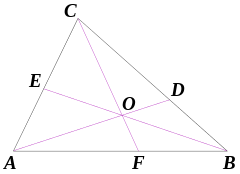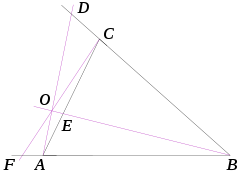Ceva's theorem
Ceva's theorem is a theorem about triangles in plane geometry. Given a triangle ABC, let the lines AO, BO and CO be drawn from the vertices to a common point O (not on one of the sides of ABC), to meet opposite sides at D, E and F respectively. (The segments AD, BE, and CF are known as cevians.) Then, using signed lengths of segments,


In other words, the length AB is taken to be positive or negative according to whether A is to the left or right of B in some fixed orientation of the line. For example, AF/FB is defined as having positive value when F is between A and B and negative otherwise.
Ceva's theorem is a theorem of affine geometry, in the sense that it may be stated and proved without using the concepts of angles, areas, and lengths (except for the ratio of the lengths of two line segments that are collinear). It is therefore true for triangles in any affine plane over any field.
A slightly adapted converse is also true: If points D, E and F are chosen on BC, AC and AB respectively so that
then AD, BE and CF are concurrent, or all three parallel. The converse is often included as part of the theorem.
The theorem is often attributed to Giovanni Ceva, who published it in his 1678 work De lineis rectis. But it was proven much earlier by Yusuf Al-Mu'taman ibn Hűd, an eleventh-century king of Zaragoza.[1]
Associated with the figures are several terms derived from Ceva's name: cevian (the lines AD, BE, CF are the cevians of O), cevian triangle (the triangle DEF is the cevian triangle of O); cevian nest, anticevian triangle, Ceva conjugate. (Ceva is pronounced Chay'va; cevian is pronounced chev'ian.)
The theorem is very similar to Menelaus' theorem in that their equations differ only in sign.
Proofs
Several proofs of the theorem have been given.[2][3] Two proofs are given in the following.
The first one is very elementary, using only basic properties of triangle areas.[2] However, several cases have to be considered, depending on the position of the point O.
The second proof uses barycentric coordinates and vectors, but is somehow more natural and not case dependent. Moreover, it works in any affine plane over any field.
Using triangle areas
First, the sign of the left-hand side is positive since either all three of the ratios are positive, the case where O is inside the triangle (upper diagram), or one is positive and the other two are negative, the case O is outside the triangle (lower diagram shows one case).
To check the magnitude, note that the area of a triangle of a given height is proportional to its base. So
Therefore,
(Replace the minus with a plus if A and O are on opposite sides of BC.) Similarly,
and
Multiplying these three equations gives
as required.
The theorem can also be proven easily using Menelaus' theorem.[4] From the transversal BOE of triangle ACF,
and from the transversal AOD of triangle BCF,
The theorem follows by dividing these two equations.
The converse follows as a corollary.[2] Let D, E and F be given on the lines BC, AC and AB so that the equation holds. Let AD and BE meet at O and let F′ be the point where CO crosses AB. Then by the theorem, the equation also holds for D, E and F′. Comparing the two,
But at most one point can cut a segment in a given ratio so F=F′.
Using barycentric coordinates
Given three points A, B, C, that are not collinear, and a point O, that belongs to the same plane, the barycentric coordinates of O with respect of A, B, C are the unique three numbers such that
and
for every point X (for the definition of this arrow notation and further details, see Affine space).
For Ceva's theorem, the point O is supposed to not belong to any line passing through two vertices of the triangle. This implies that
If one takes for X the intersection F of the lines AB and OC (see figures), the last equation may be rearranged into
The left-hand side of this equation is a vector that has the same direction as the line CF, and the right-hand side has the same direction as the line AB. These lines have different directions since A, B, and C are not collinear. It follows that the two members of the equation equal the zero vector, and
It follows that
where the left-hand-side fraction is the signed ratio of the lengths of the collinear line segments AF and FB.
The same reasoning shows
Ceva's theorem results immediately by taking the product of the three last equations.
Generalizations
The theorem can be generalized to higher-dimensional simplexes using barycentric coordinates. Define a cevian of an n-simplex as a ray from each vertex to a point on the opposite (n-1)-face (facet). Then the cevians are concurrent if and only if a mass distribution can be assigned to the vertices such that each cevian intersects the opposite facet at its center of mass. Moreover, the intersection point of the cevians is the center of mass of the simplex.[5][6]
Routh's theorem gives the area of the triangle formed by three cevians in the case that they are not concurrent. Ceva's theorem can be obtained from it by setting the area equal to zero and solving.
The analogue of the theorem for general polygons in the plane has been known since the early nineteenth century.[7] The theorem has also been generalized to triangles on other surfaces of constant curvature.[8]
See also
- Projective geometry
- Median (geometry) – an application
References
- Holme, Audun (2010). Geometry: Our Cultural Heritage. Springer. p. 210. ISBN 3-642-14440-3.
- Russell, John Wellesley (1905). "Ch. 1 §7 Ceva's Theorem". Pure Geometry. Clarendon Press.
- Alfred S. Posamentier and Charles T. Salkind (1996), Challenging Problems in Geometry, pages 177–180, Dover Publishing Co., second revised edition.
- Follows Hopkins, George Irving (1902). "Art. 986". Inductive Plane Geometry. D.C. Heath & Co.
- Landy, Steven (December 1988). "A Generalization of Ceva's Theorem to Higher Dimensions". The American Mathematical Monthly. 95 (10): 936–939. doi:10.2307/2322390. JSTOR 2322390.
- Wernicke, Paul (November 1927). "The Theorems of Ceva and Menelaus and Their Extension". The American Mathematical Monthly. 34 (9): 468–472. doi:10.2307/2300222. JSTOR 2300222.
- Grünbaum, Branko; Shephard, G. C. (1995). "Ceva, Menelaus and the Area Principle". Mathematics Magazine. 68 (4): 254–268. doi:10.2307/2690569. JSTOR 2690569.
- Masal'tsev, L. A. (1994). "Incidence theorems in spaces of constant curvature". Journal of Mathematical Sciences. 72 (4): 3201–3206. doi:10.1007/BF01249519.
Further reading
- Hogendijk, J. B. (1995). "Al-Mutaman ibn Hűd, 11the century king of Saragossa and brilliant mathematician". Historia Mathematica. 22: 1–18. doi:10.1006/hmat.1995.1001.CS1 maint: ref=harv (link)
External links
- Menelaus and Ceva at MathPages
- Derivations and applications of Ceva's Theorem at cut-the-knot
- Trigonometric Form of Ceva's Theorem at cut-the-knot
- Glossary of Encyclopedia of Triangle Centers includes definitions of cevian triangle, cevian nest, anticevian triangle, Ceva conjugate, and cevapoint
- Conics Associated with a Cevian Nest, by Clark Kimberling
- Ceva's Theorem by Jay Warendorff, Wolfram Demonstrations Project.
- Weisstein, Eric W. "Ceva's Theorem". MathWorld.
- Experimentally finding the centroid of a triangle with different weights at the vertices: a practical application of Ceva's theorem at Dynamic Geometry Sketches, an interactive dynamic geometry sketch using the gravity simulator of Cinderella.
- "Ceva theorem", Encyclopedia of Mathematics, EMS Press, 2001 [1994]